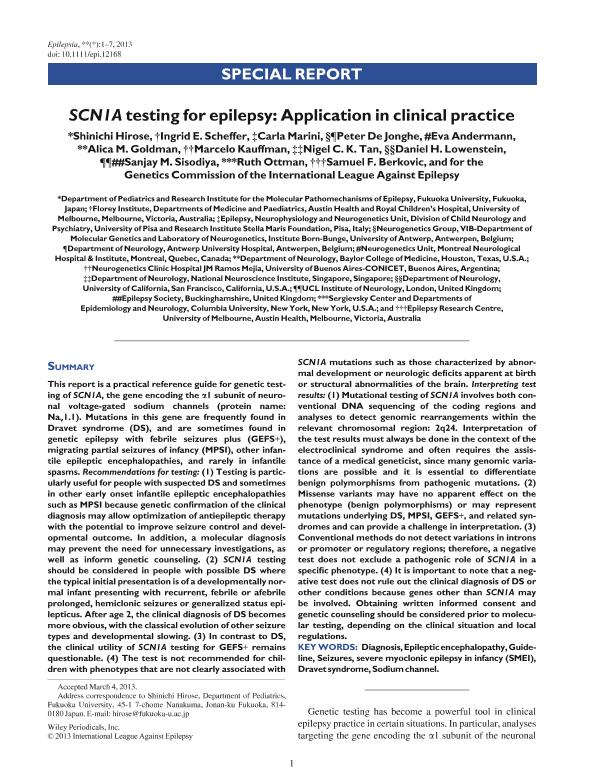Mostrar el registro sencillo del ítem
dc.contributor.author
Hirose, Shinichi

dc.contributor.author
Scheffer, Ingrid E.

dc.contributor.author
Marini, Carla

dc.contributor.author
De Jonghe, Peter

dc.contributor.author
Andermann, Eva

dc.contributor.author
Goldman, Alica M.

dc.contributor.author
Kauffman, Marcelo Andres

dc.contributor.author
Tan, Nigel C. K.

dc.contributor.author
Lowenstein, Daniel H.

dc.contributor.author
Sisodiya, Sanjay M.

dc.contributor.author
Ottman, Ruth

dc.contributor.author
Berkovic, Samuel F.

dc.contributor.author
The Genetics Commission of the International League Against Epilepsy
dc.date.available
2017-06-06T18:36:39Z
dc.date.issued
2013-05
dc.identifier.citation
Hirose, Shinichi; Scheffer, Ingrid E.; Marini, Carla; De Jonghe, Peter; Andermann, Eva; et al.; SCN1A testing for epilepsy: application in clinical practice; Wiley; Epilepsia; 54; 5; 5-2013; 946-952
dc.identifier.issn
0013-9580
dc.identifier.uri
http://hdl.handle.net/11336/17587
dc.description.abstract
This report is a practical reference guide for genetic testing of SCN1A, the gene encoding the α1 subunit of neuronal voltage-gated sodium channels (protein name: Nav1.1). Mutations in this gene are frequently found in Dravet syndrome (DS), and are sometimes found in genetic epilepsy with febrile seizures plus (GEFS+), migrating partial seizures of infancy (MPSI), other infantile epileptic encephalopathies, and rarely in infantile spasms. Recommendations for testing: (1) Testing is particularly useful for people with suspected DS and sometimes in other early onset infantile epileptic encephalopathies such as MPSI because genetic confirmation of the clinical diagnosis may allow optimization of antiepileptic therapy with the potential to improve seizure control and developmental outcome. In addition, a molecular diagnosis may prevent the need for unnecessary investigations, as well as inform genetic counseling. (2) SCN1A testing should be considered in people with possible DS where the typical initial presentation is of a developmentally normal infant presenting with recurrent, febrile or afebrile prolonged, hemiclonic seizures or generalized status epilepticus. After age 2, the clinical diagnosis of DS becomes more obvious, with the classical evolution of other seizure types and developmental slowing. (3) In contrast to DS, the clinical utility of SCN1A testing for GEFS+ remains questionable. (4) The test is not recommended for children with phenotypes that are not clearly associated with SCN1A mutations such as those characterized by abnormal development or neurologic deficits apparent at birth or structural abnormalities of the brain. Interpreting test results: (1) Mutational testing of SCN1A involves both conventional DNA sequencing of the coding regions and analyses to detect genomic rearrangements within the relevant chromosomal region: 2q24. Interpretation of the test results must always be done in the context of the electroclinical syndrome and often requires the assistance of a medical geneticist, since many genomic variations are possible and it is essential to differentiate benign polymorphisms from pathogenic mutations. (2) Missense variants may have no apparent effect on the phenotype (benign polymorphisms) or may represent mutations underlying DS, MPSI, GEFS+, and related syndromes and can provide a challenge in interpretation. (3) Conventional methods do not detect variations in introns or promoter or regulatory regions; therefore, a negative test does not exclude a pathogenic role of SCN1A in a specific phenotype. (4) It is important to note that a negative test does not rule out the clinical diagnosis of DS or other conditions because genes other than SCN1A may be involved. Obtaining written informed consent and genetic counseling should be considered prior to molecular testing, depending on the clinical situation and local regulations.
dc.format
application/pdf
dc.language.iso
eng
dc.publisher
Wiley

dc.rights
info:eu-repo/semantics/openAccess
dc.rights.uri
https://creativecommons.org/licenses/by-nc-sa/2.5/ar/
dc.subject
Genetic
dc.subject
Epilepsy
dc.subject.classification
Neurología Clínica

dc.subject.classification
Medicina Clínica

dc.subject.classification
CIENCIAS MÉDICAS Y DE LA SALUD

dc.title
SCN1A testing for epilepsy: application in clinical practice
dc.type
info:eu-repo/semantics/article
dc.type
info:ar-repo/semantics/artículo
dc.type
info:eu-repo/semantics/publishedVersion
dc.date.updated
2017-05-26T14:42:06Z
dc.identifier.eissn
1528-1167
dc.journal.volume
54
dc.journal.number
5
dc.journal.pagination
946-952
dc.journal.pais
Estados Unidos

dc.journal.ciudad
Hoboken
dc.description.fil
Fil: Hirose, Shinichi. Fukuoka University; Japón
dc.description.fil
Fil: Scheffer, Ingrid E.. The University of Melbourne; Australia
dc.description.fil
Fil: Marini, Carla. Università degli Studi di Pisa; Italia
dc.description.fil
Fil: De Jonghe, Peter. Universiteit Antwerpen; Bélgica
dc.description.fil
Fil: Andermann, Eva. McGill University. Montreal Neurological Institute and Hospital; Canadá
dc.description.fil
Fil: Goldman, Alica M.. Baylor College of Medicine; Estados Unidos
dc.description.fil
Fil: Kauffman, Marcelo Andres. Consejo Nacional de Investigaciones Científicas y Técnicas; Argentina. Gobierno de la Ciudad de Buenos Aires. Hospital General de Agudos "Ramos Mejía"; Argentina
dc.description.fil
Fil: Tan, Nigel C. K.. National Neuroscience Institute; Singapur
dc.description.fil
Fil: Lowenstein, Daniel H.. University of California; Estados Unidos
dc.description.fil
Fil: Sisodiya, Sanjay M.. University College London; Estados Unidos. Epilepsy Society; Reino Unido
dc.description.fil
Fil: Ottman, Ruth. Columbia University; Estados Unidos
dc.description.fil
Fil: Berkovic, Samuel F.. The University of Melbourne; Australia
dc.description.fil
Fil: The Genetics Commission of the International League Against Epilepsy.
dc.journal.title
Epilepsia

dc.relation.alternativeid
info:eu-repo/semantics/altIdentifier/url/http://onlinelibrary.wiley.com/doi/10.1111/epi.12168/abstract
dc.relation.alternativeid
info:eu-repo/semantics/altIdentifier/doi/http://dx.doi.org/10.1111/epi.12168
Archivos asociados
